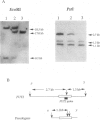Abstract
About 20%-25% of Caucasian individuals are nonsecretors who fail to express soluble A, B, H, and Lewis b histo-blood group antigens in secretory organs and secretory fluids because of the absence of the Secretor gene (FUT2)-encoded alpha(1,2)-fucosyltransferase (Se enzyme) activity. Recently, the FUT2 and a pseudogene have been isolated, and an Se enzyme-deficient allele (se) caused by a nonsense mutation (G428A, se1) in Caucasians has also been reported. Although we were unable to find the se1 allele, we have found a missense mutation (A385T, se2) and two nonsense mutations (C571T, se3 and C628T, se4) in the Japanese Se enzyme-deficient alleles. In addition, we have found a fusion gene, which consisted of the 5'-region of the pseudogene and the 3'-region of the functional FUT2, as a Se enzyme-deficient allele (se5). The DNA sequence analysis of the fusion gene indicated that the crossover region corresponded to regions between bases 253 and 313 of the pseudogene and between bases 211 and 271 of the FUT2. This finding suggested that the fusion gene was generated by homologous but unequal crossover. A population study on 141 randomly selected Japanese has indicated that the se2 is a common Se enzyme-deficient allele in the Japanese population. The results suggest that Se enzyme-deficient alleles are race specific.
Full text
PDF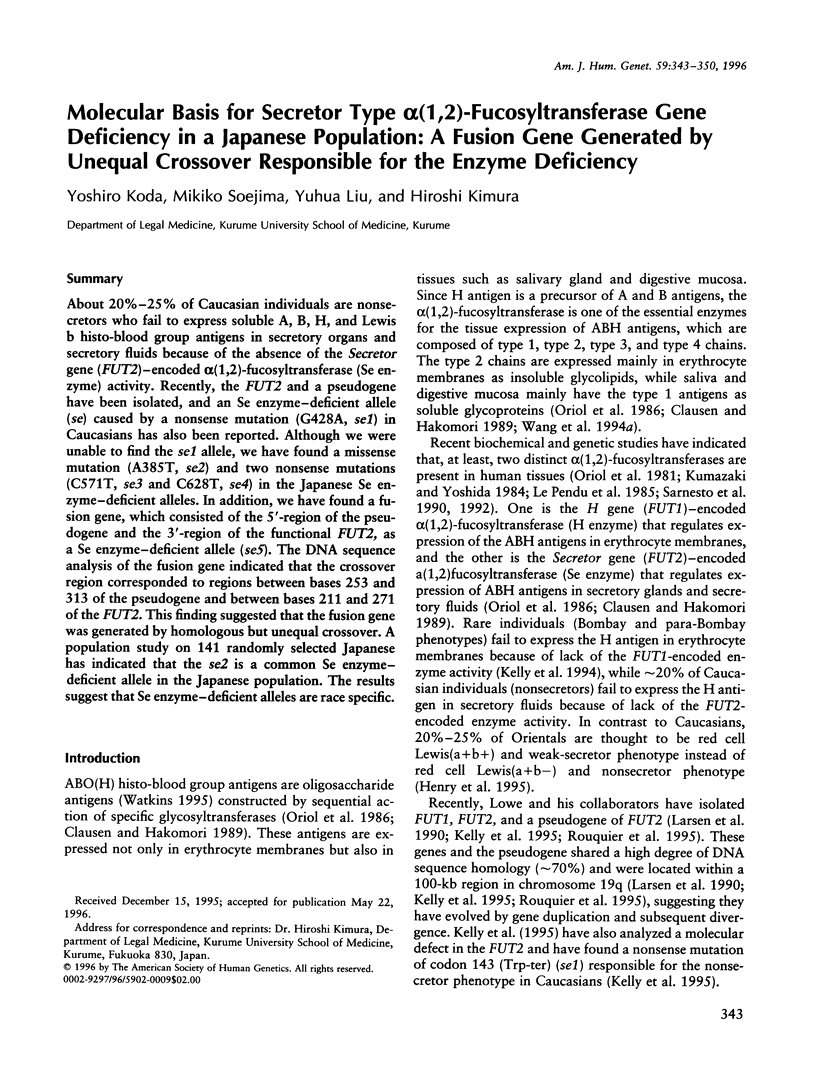

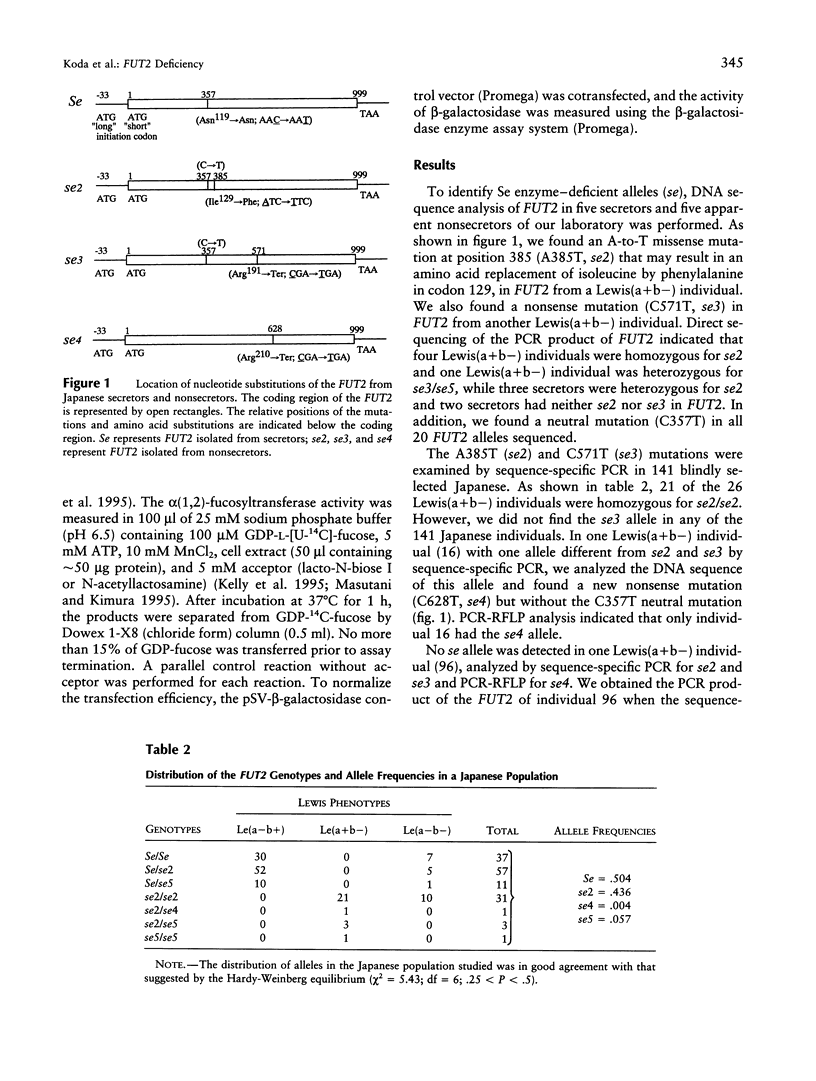
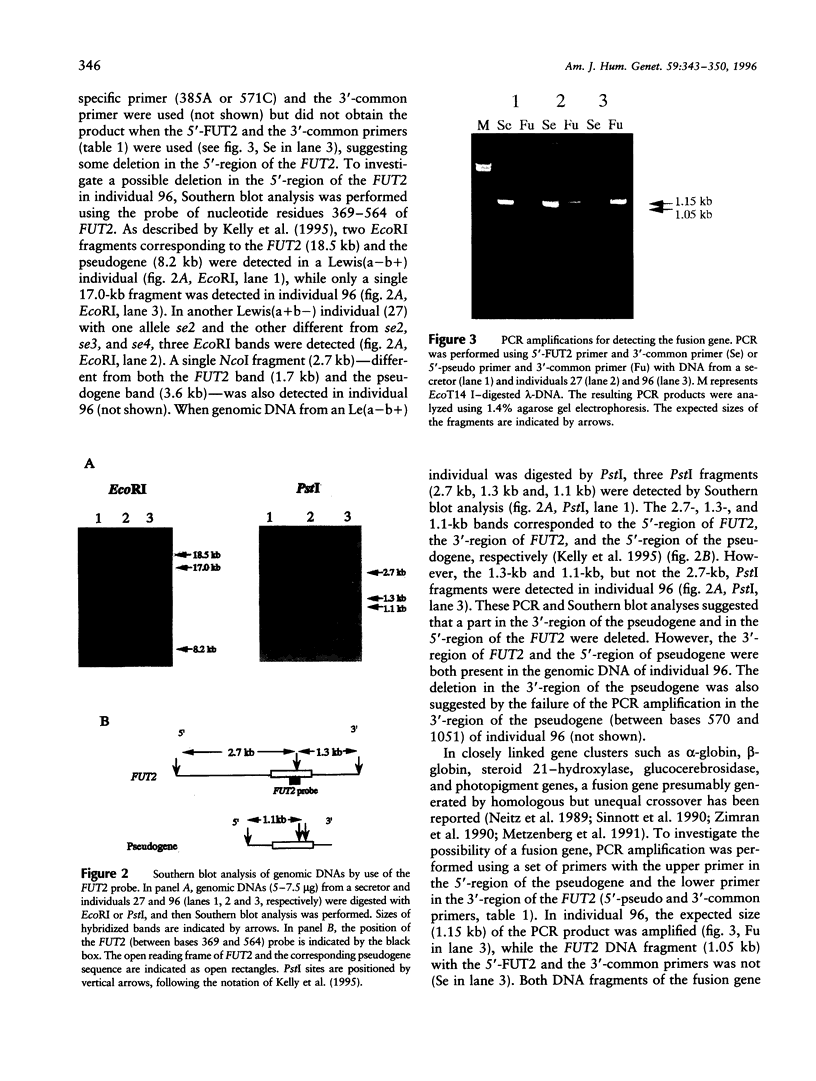
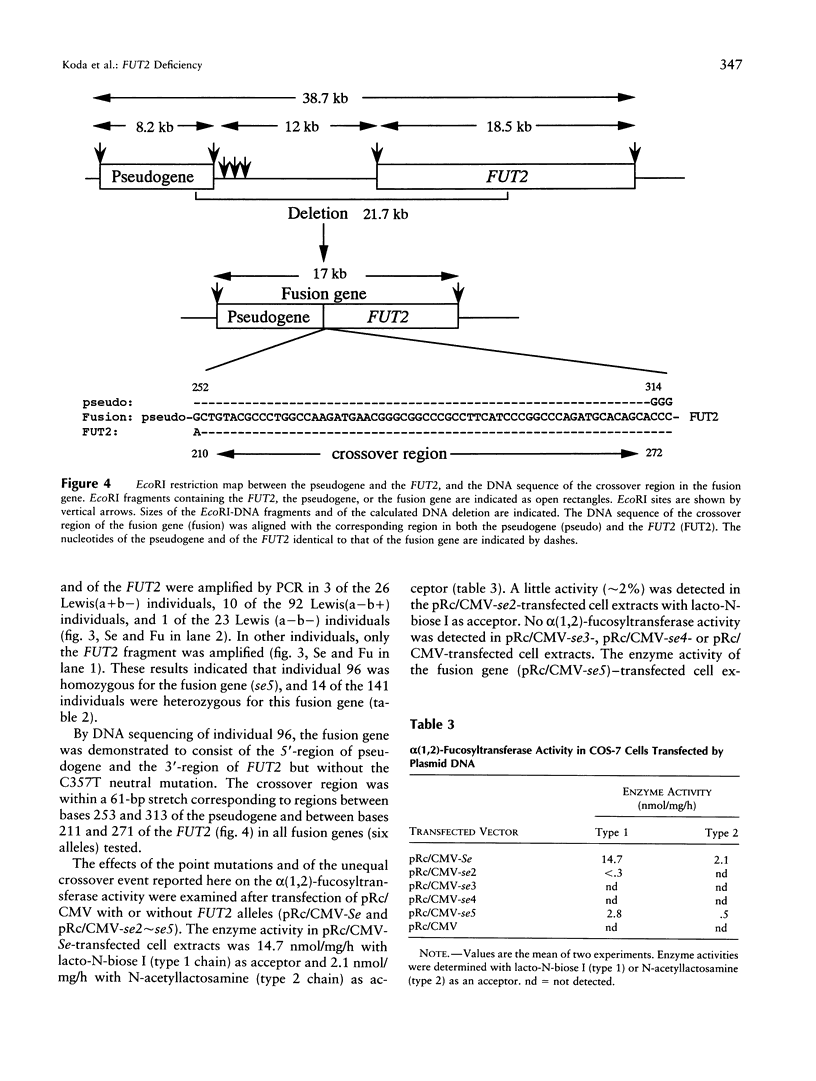
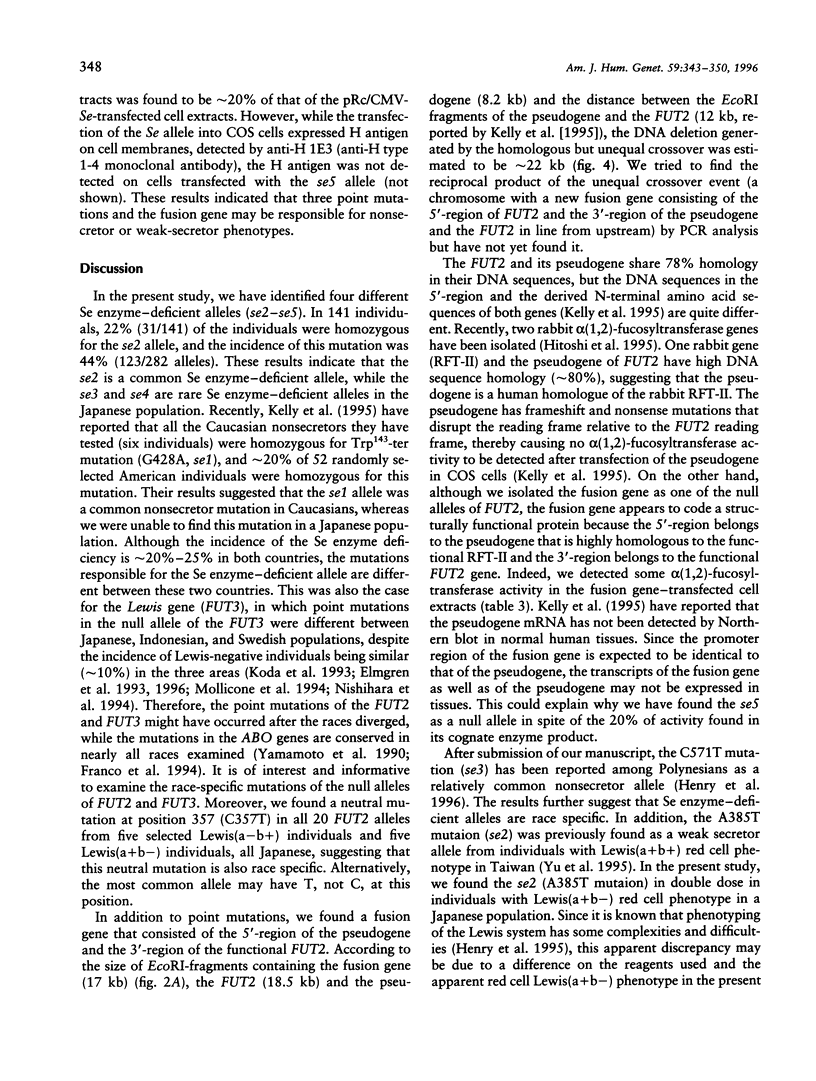
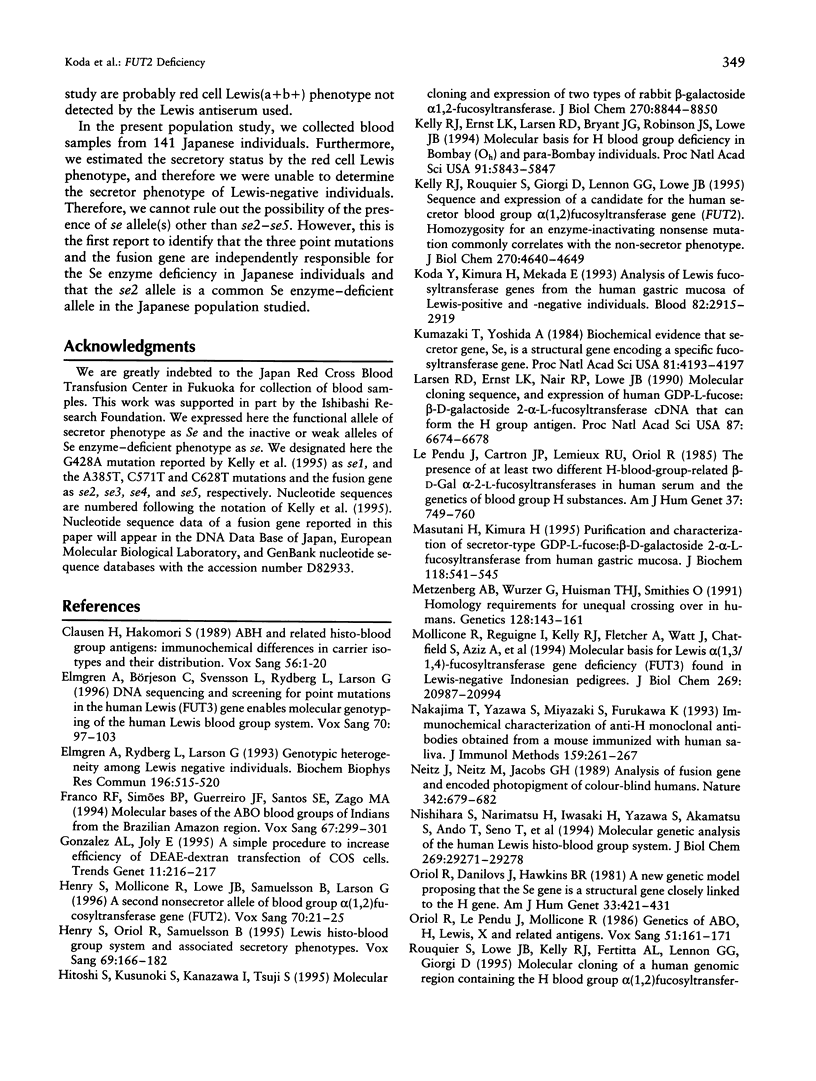
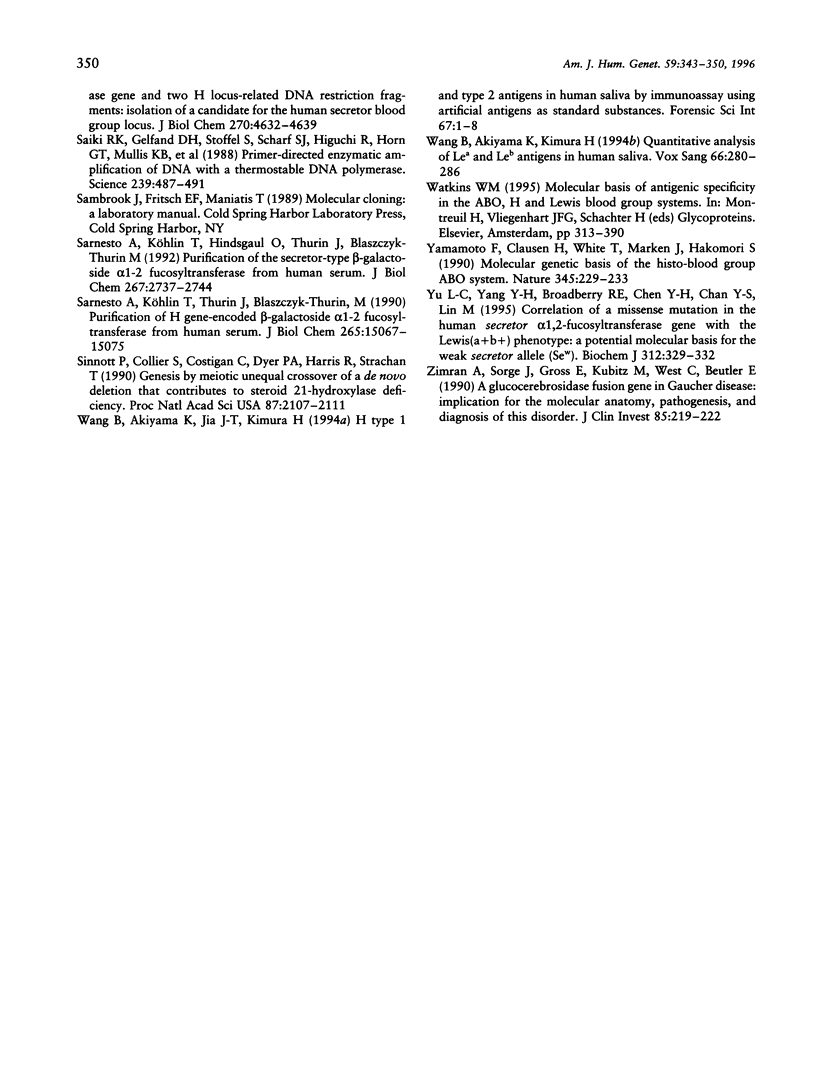
Images in this article
Selected References
These references are in PubMed. This may not be the complete list of references from this article.
- Clausen H., Hakomori S. ABH and related histo-blood group antigens; immunochemical differences in carrier isotypes and their distribution. Vox Sang. 1989;56(1):1–20. doi: 10.1111/j.1423-0410.1989.tb03040.x. [DOI] [PubMed] [Google Scholar]
- Elmgren A., Börjeson C., Svensson L., Rydberg L., Larson G. DNA sequencing and screening for point mutations in the human Lewis (FUT3) gene enables molecular genotyping of the human Lewis blood group system. Vox Sang. 1996;70(2):97–103. doi: 10.1111/j.1423-0410.1996.tb01300.x. [DOI] [PubMed] [Google Scholar]
- Elmgren A., Rydberg L., Larson G. Genotypic heterogeneity among Lewis negative individuals. Biochem Biophys Res Commun. 1993 Oct 29;196(2):515–520. doi: 10.1006/bbrc.1993.2280. [DOI] [PubMed] [Google Scholar]
- Franco R. F., Simões B. P., Guerreiro J. F., Santos S. E., Zago M. A. Molecular bases of the ABO blood groups of Indians from the Brazilian Amazon region. Vox Sang. 1994;67(3):299–301. doi: 10.1111/j.1423-0410.1994.tb01255.x. [DOI] [PubMed] [Google Scholar]
- Gonzalez A. L., Joly E. A simple procedure to increase efficiency of DEAE-dextran transfection of COS cells. Trends Genet. 1995 Jun;11(6):216–217. doi: 10.1016/s0168-9525(00)89051-4. [DOI] [PubMed] [Google Scholar]
- Henry S., Mollicone R., Lowe J. B., Samuelsson B., Larson G. A second nonsecretor allele of the blood group alpha(1,2)fucosyl-transferase gene (FUT2). Vox Sang. 1996;70(1):21–25. doi: 10.1111/j.1423-0410.1996.tb00991.x. [DOI] [PubMed] [Google Scholar]
- Henry S., Oriol R., Samuelsson B. Lewis histo-blood group system and associated secretory phenotypes. Vox Sang. 1995;69(3):166–182. doi: 10.1111/j.1423-0410.1995.tb02591.x. [DOI] [PubMed] [Google Scholar]
- Hitoshi S., Kusunoki S., Kanazawa I., Tsuji S. Molecular cloning and expression of two types of rabbit beta-galactoside alpha 1,2-fucosyltransferase. J Biol Chem. 1995 Apr 14;270(15):8844–8850. doi: 10.1074/jbc.270.15.8844. [DOI] [PubMed] [Google Scholar]
- Kelly R. J., Ernst L. K., Larsen R. D., Bryant J. G., Robinson J. S., Lowe J. B. Molecular basis for H blood group deficiency in Bombay (Oh) and para-Bombay individuals. Proc Natl Acad Sci U S A. 1994 Jun 21;91(13):5843–5847. doi: 10.1073/pnas.91.13.5843. [DOI] [PMC free article] [PubMed] [Google Scholar]
- Kelly R. J., Rouquier S., Giorgi D., Lennon G. G., Lowe J. B. Sequence and expression of a candidate for the human Secretor blood group alpha(1,2)fucosyltransferase gene (FUT2). Homozygosity for an enzyme-inactivating nonsense mutation commonly correlates with the non-secretor phenotype. J Biol Chem. 1995 Mar 3;270(9):4640–4649. doi: 10.1074/jbc.270.9.4640. [DOI] [PubMed] [Google Scholar]
- Koda Y., Kimura H., Mekada E. Analysis of Lewis fucosyltransferase genes from the human gastric mucosa of Lewis-positive and -negative individuals. Blood. 1993 Nov 1;82(9):2915–2919. [PubMed] [Google Scholar]
- Kumazaki T., Yoshida A. Biochemical evidence that secretor gene, Se, is a structural gene encoding a specific fucosyltransferase. Proc Natl Acad Sci U S A. 1984 Jul;81(13):4193–4197. doi: 10.1073/pnas.81.13.4193. [DOI] [PMC free article] [PubMed] [Google Scholar]
- Larsen R. D., Ernst L. K., Nair R. P., Lowe J. B. Molecular cloning, sequence, and expression of a human GDP-L-fucose:beta-D-galactoside 2-alpha-L-fucosyltransferase cDNA that can form the H blood group antigen. Proc Natl Acad Sci U S A. 1990 Sep;87(17):6674–6678. doi: 10.1073/pnas.87.17.6674. [DOI] [PMC free article] [PubMed] [Google Scholar]
- Le Pendu J., Cartron J. P., Lemieux R. U., Oriol R. The presence of at least two different H-blood-group-related beta-D-gal alpha-2-L-fucosyltransferases in human serum and the genetics of blood group H substances. Am J Hum Genet. 1985 Jul;37(4):749–760. [PMC free article] [PubMed] [Google Scholar]
- Masutani H., Kimura H. Purification and characterization of secretory-type GDP-L-fucose: beta-D-galactoside 2-alpha-L-fucosyltransferase from human gastric mucosa. J Biochem. 1995 Sep;118(3):541–545. doi: 10.1093/oxfordjournals.jbchem.a124942. [DOI] [PubMed] [Google Scholar]
- Metzenberg A. B., Wurzer G., Huisman T. H., Smithies O. Homology requirements for unequal crossing over in humans. Genetics. 1991 May;128(1):143–161. doi: 10.1093/genetics/128.1.143. [DOI] [PMC free article] [PubMed] [Google Scholar]
- Mollicone R., Reguigne I., Kelly R. J., Fletcher A., Watt J., Chatfield S., Aziz A., Cameron H. S., Weston B. W., Lowe J. B. Molecular basis for Lewis alpha(1,3/1,4)-fucosyltransferase gene deficiency (FUT3) found in Lewis-negative Indonesian pedigrees. J Biol Chem. 1994 Aug 19;269(33):20987–20994. [PubMed] [Google Scholar]
- Nakajima T., Yazawa S., Miyazaki S., Furukawa K. Immunochemical characterization of anti-H monoclonal antibodies obtained from a mouse immunized with human saliva. J Immunol Methods. 1993 Feb 26;159(1-2):261–267. doi: 10.1016/0022-1759(93)90165-4. [DOI] [PubMed] [Google Scholar]
- Neitz J., Neitz M., Jacobs G. H. Analysis of fusion gene and encoded photopigment of colour-blind humans. Nature. 1989 Dec 7;342(6250):679–682. doi: 10.1038/342679a0. [DOI] [PubMed] [Google Scholar]
- Nishihara S., Narimatsu H., Iwasaki H., Yazawa S., Akamatsu S., Ando T., Seno T., Narimatsu I. Molecular genetic analysis of the human Lewis histo-blood group system. J Biol Chem. 1994 Nov 18;269(46):29271–29278. [PubMed] [Google Scholar]
- Oriol R., Danilovs J., Hawkins B. R. A new genetic model proposing that the Se gene is a structural gene closely linked to the H gene. Am J Hum Genet. 1981 May;33(3):421–431. [PMC free article] [PubMed] [Google Scholar]
- Oriol R., Le Pendu J., Mollicone R. Genetics of ABO, H, Lewis, X and related antigens. Vox Sang. 1986;51(3):161–171. doi: 10.1111/j.1423-0410.1986.tb01946.x. [DOI] [PubMed] [Google Scholar]
- Saiki R. K., Gelfand D. H., Stoffel S., Scharf S. J., Higuchi R., Horn G. T., Mullis K. B., Erlich H. A. Primer-directed enzymatic amplification of DNA with a thermostable DNA polymerase. Science. 1988 Jan 29;239(4839):487–491. doi: 10.1126/science.2448875. [DOI] [PubMed] [Google Scholar]
- Sarnesto A., Köhlin T., Hindsgaul O., Thurin J., Blaszczyk-Thurin M. Purification of the secretor-type beta-galactoside alpha 1----2-fucosyltransferase from human serum. J Biol Chem. 1992 Feb 5;267(4):2737–2744. [PubMed] [Google Scholar]
- Sarnesto A., Köhlin T., Thurin J., Blaszczyk-Thurin M. Purification of H gene-encoded beta-galactoside alpha 1----2 fucosyltransferase from human serum. J Biol Chem. 1990 Sep 5;265(25):15067–15075. [PubMed] [Google Scholar]
- Sinnott P., Collier S., Costigan C., Dyer P. A., Harris R., Strachan T. Genesis by meiotic unequal crossover of a de novo deletion that contributes to steroid 21-hydroxylase deficiency. Proc Natl Acad Sci U S A. 1990 Mar;87(6):2107–2111. doi: 10.1073/pnas.87.6.2107. [DOI] [PMC free article] [PubMed] [Google Scholar]
- Wang B., Akiyama K., Jia J. T., Kimura H. Measuring H type 1 and H type 2 antigens in human saliva by immunoassay using artificial antigens as standard substances. Forensic Sci Int. 1994 Jun 28;67(1):1–8. doi: 10.1016/0379-0738(94)90405-7. [DOI] [PubMed] [Google Scholar]
- Wang B., Akiyama K., Kimura H. Quantitative analysis of Le(a) and Le(b) antigens in human saliva. Vox Sang. 1994;66(4):280–286. doi: 10.1111/j.1423-0410.1994.tb00330.x. [DOI] [PubMed] [Google Scholar]
- Yamamoto F., Clausen H., White T., Marken J., Hakomori S. Molecular genetic basis of the histo-blood group ABO system. Nature. 1990 May 17;345(6272):229–233. doi: 10.1038/345229a0. [DOI] [PubMed] [Google Scholar]
- Yu L. C., Yang Y. H., Broadberry R. E., Chen Y. H., Chan Y. S., Lin M. Correlation of a missense mutation in the human Secretor alpha 1,2-fucosyltransferase gene with the Lewis(a+b+) phenotype: a potential molecular basis for the weak Secretor allele (Sew). Biochem J. 1995 Dec 1;312(Pt 2):329–332. doi: 10.1042/bj3120329. [DOI] [PMC free article] [PubMed] [Google Scholar]
- Zimran A., Sorge J., Gross E., Kubitz M., West C., Beutler E. A glucocerebrosidase fusion gene in Gaucher disease. Implications for the molecular anatomy, pathogenesis, and diagnosis of this disorder. J Clin Invest. 1990 Jan;85(1):219–222. doi: 10.1172/JCI114415. [DOI] [PMC free article] [PubMed] [Google Scholar]



